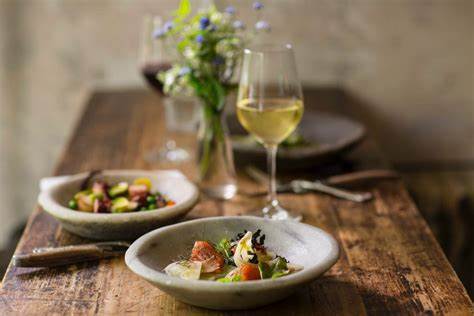Introduction:
Food and wine have a magical way of elevating each other, creating a symphony of flavours and textures that tantalise the taste buds and delight the senses. When it comes to pairing white wine with food, the possibilities are endless. From light and crisp Sauvignon Blanc to rich and buttery Chardonnay, white wines offer a wide range of flavours and styles that complement a variety of dishes. In this guide, we’ll explore the art of pairing white wine with food, sharing tips and tricks to help you create culinary harmony at your next meal.
- Understanding Flavour Profiles:
The key to successful wine and food pairing lies in understanding the flavour profiles of both the wine and the dish. White wines are generally characterised by crisp acidity, fruity flavours, and floral aromas, which can range from citrus and green apple to tropical fruits and honey. When pairing white wine with food, look for dishes that either complement or contrast with these flavours to create balance and harmony on the palate.
- Matching Intensity:
One of the fundamental principles of wine pairing is matching the intensity of the wine with the intensity of the dish. Lighter-bodied white wines like Pinot Grigio or Sauvignon Blanc pair well with lighter dishes such as salads, seafood, and poultry, while fuller-bodied white wines like Chardonnay or Viognier are better suited to richer, more flavourful dishes like creamy pastas, roasted meats, and aged cheeses. The goal is to ensure that neither the wine nor the food overwhelms the other, but rather that they enhance each other’s flavours.
- Considering Texture:
In addition to flavour intensity, consider the texture of both the wine and the food when pairing white wine with dishes. Crisp, acidic white wines like Sauvignon Blanc or Grüner Veltliner are a natural match for dishes with a light and refreshing texture, such as salads, ceviche, or sushi. Rich and creamy white wines like Chardonnay or Viognier, on the other hand, pair beautifully with dishes that have a creamy or buttery texture, such as risotto, roasted chicken, or lobster thermidor. Matching the texture of the wine with the texture of the food creates a harmonious dining experience that’s sure to impress your guests.
- Balancing Sweetness and Acidity:
Another important consideration when pairing white wine with food is balancing sweetness and acidity. Sweet white wines like Riesling or Moscato pair well with spicy or salty dishes, as the sweetness helps to balance out the heat or saltiness of the food. Crisp, acidic white wines like Sauvignon Blanc or Albariño, on the other hand, are a refreshing counterpoint to rich or fatty dishes, cutting through the richness and cleansing the palate. Experiment with different combinations to find the perfect balance of sweetness and acidity for your palate.
- Matching Regional Pairings:
When in doubt, look to the cuisine of the wine’s region of origin for inspiration when pairing white wine with food. For example, pair Italian Pinot Grigio with classic Italian dishes like pasta primavera or seafood risotto, or French Chablis with French classics like coq au vin or escargot. Matching the flavours and ingredients of the wine with those of the food creates a natural synergy that enhances the dining experience and transports you to the wine’s country of origin.
- Experimenting with Contrasts:
While matching the flavours and textures of the wine and food is important, don’t be afraid to experiment with contrasting pairings as well. Sometimes, unexpected combinations can create delightful surprises on the palate. For example, try pairing a crisp, acidic Sauvignon Blanc with spicy Thai curry or a buttery Chardonnay with tangy goat cheese. The key is to trust your palate and be open to new experiences.
- Serving Temperature:
Lastly, be mindful of the serving temperature of both the wine and the food when pairing white wine with dishes. White wines are best served chilled, typically between 45-55°F (7-13°C), which helps to preserve their crispness and acidity. Avoid serving white wines too cold, as this can mute their flavours and aromas. Similarly, take care not to serve white wines too warm, as this can make them taste flabby and overly alcoholic. Aim to serve white wines at the appropriate temperature to ensure optimal enjoyment.
Conclusion:
Pairing white wine with food is a delightful adventure that invites you to explore the endless possibilities of flavour and texture. By understanding the flavour profiles of both the wine and the dish, matching intensity and texture, balancing sweetness and acidity, and experimenting with regional and contrasting pairings, you can create culinary harmony that delights the senses and enhances the dining experience. So raise a glass to the joys of white wine and happy pairing! Cheers!








































































